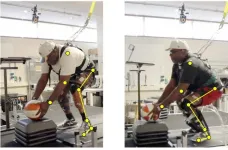(Press-News.org) Despite increasing concern over the intrusion of algorithms in daily life, people may be more willing to trust a computer program than their fellow humans, especially if a task becomes too challenging, according to new research from data scientists at the University of Georgia.
From choosing the next song on your playlist to choosing the right size pants, people are relying more on the advice of algorithms to help make everyday decisions and streamline their lives.
"Algorithms are able to do a huge number of tasks, and the number of tasks that they are able to do is expanding practically every day," said Eric Bogert, a Ph.D. student in the Terry College of Business Department of Management Information Systems. "It seems like there's a bias towards leaning more heavily on algorithms as a task gets harder and that effect is stronger than the bias towards relying on advice from other people."
Bogert worked with management information systems professor Rick Watson and assistant professor Aaron Schecter on the paper, "Humans rely more on algorithms than social influence as a task becomes more difficult," which was published April 13 in Nature's Scientific Reports journal.
Their study, which involved 1,500 individuals evaluating photographs, is part of a larger body of work analyzing how and when people work with algorithms to process information and make decisions.
For this study, the team asked volunteers to count the number of people in a photograph of a crowd and supplied suggestions that were generated by a group of other people and suggestions generated by an algorithm.
As the number of people in the photograph expanded, counting became more difficult and people were more likely to follow the suggestion generated by an algorithm rather than count themselves¬ or follow the "wisdom of the crowd," Schecter said.
Schecter explained that the choice of counting as the trial task was an important one because the number of people in the photo makes the task objectively harder as it increases. It also is the type of task that laypeople expect computers to be good at.
"This is a task that people perceive that a computer will be good at, even though it might be more subject to bias than counting objects," Schecter said. "One of the common problems with AI is when it is used for awarding credit or approving someone for loans. While that is a subjective decision, there are a lot of numbers in there -- like income and credit score -- so people feel like this is a good job for an algorithm. But we know that dependence leads to discriminatory practices in many cases because of social factors that aren't considered."
Facial recognition and hiring algorithms have come under scrutiny in recent years as well because their use has revealed cultural biases in the way they were built, which can cause inaccuracies when matching faces to identities or screening for qualified job candidates, Schecter said.
Those biases may not be present in a simple task like counting, but their presence in other trusted algorithms is a reason why it's important to understand how people rely on algorithms when making decisions, he added.
This study was part of Schecter's larger research program into human-machine collaboration, which is funded by a $300,000 grant from the U.S. Army Research Office.
"The eventual goal is to look at groups of humans and machines making decisions and find how we can get them to trust each other and how that changes their behavior," Schecter said. "Because there's very little research in that setting, we're starting with the fundamentals."
Schecter, Watson and Bogert are currently studying how people rely on algorithms when making creative judgments and moral judgments, like writing descriptive passages and setting bail of prisoners.
INFORMATION:
For information into Schecter's complete research program visit aaronschecter.com.
A recent case study from North Carolina State University and the University of North Carolina at Chapel Hill demonstrates that, with training, neural control of a powered prosthetic ankle can restore a wide range of abilities, including standing on very challenging surfaces and squatting. The researchers are currently working with a larger group of study participants to see how broadly applicable the findings may be.
"This case study shows that it is possible to use these neural control technologies, in which devices respond to electrical signals from a patient's muscles, to help patients using robotic prosthetic ankles move more naturally and intuitively," says Helen Huang, corresponding author of the study. Huang ...
The immune response to tuberculosis (TB) differs in adults and newborn babies due to the way immune cells use energy to kick into gear in a bid to kill the bacteria. This fresh discovery - just published in leading journal, Frontiers in Immunology - offers hope for improving treatments for what remains a deadly disease.
TB is still one of the biggest infectious killers in the world and babies are more likely than adults to get this infection and for it to spread outside of the lungs. Thanks to the work of scientists in Professor Joseph Keane's TB Immunology lab, based ...
An observational study of patients in London hospitals suggests that the B.1.1.7. variant is not associated with more severe illness and death, but appears to lead to higher viral load, consistent with emerging evidence that this lineage is more transmissible than the original COVID-19 strain.
A separate observational study using data logged by 37,000 UK users of a self-reporting COVID-19 symptom app found no evidence that B.1.1.7. altered symptoms or likelihood of experiencing long COVID.
Authors of both studies acknowledge that these findings ...
It has been long been known that cannabis users develop psychosis more often than non-users, but what is still not fully clear is whether cannabis actually causes psychosis and, if so, who is most at risk. A new study published in Translational Psychiatry by researchers at the Centre for Addiction and Mental Health (CAMH) and King's College London helps shed light on both questions. The research shows that while cannabis users had higher rates of psychotic experiences than non-users across the board, the difference was especially pronounced among those with high genetic predisposition to schizophrenia.
"These results are significant because ...
COLUMBUS, Ohio ¬- New data published by researchers at The Ohio State University Comprehensive Cancer Center - Arthur G. James Cancer Hospital and Richard J. Solove Research Institute (OSUCCC - James) suggests that an oral drug currently used in the clinical setting to treat neuromuscular diseases could also help prevent a common form of skin cancer caused by damage from ultraviolet-B (UVB) radiation from the sun.
While this data was gathered from preclinical studies, senior author Sujit Basu, MD, PhD, says preliminary results in animal models are very promising and worthy of immediate further investigation through phase I human studies. ...
Studies show wearing masks and social distancing can contain the spread of the COVID-19 virus, but their combined effectiveness is not precisely known.
In Chaos, by AIP Publishing, researchers at New York University Tandon School of Engineering and Politecnico di Torino in Italy developed a network model to study the effects of these two measures on the spread of airborne diseases like COVID-19. The model shows viral outbreaks can be prevented if at least 60% of a population complies with both measures.
"Neither social distancing nor mask wearing alone are likely sufficient to halt the spread of COVID-19, unless almost the entire population adheres to the single measure," author Maurizio Porfiri said. "But if a significant fraction of the ...
Extremely precise measurements are possible using atom interferometers that employ the wave character of atoms for this purpose. They can thus be used, for example, to measure the gravitational field of the Earth or to detect gravitational waves. A team of scientists from Germany has now managed to successfully perform atom interferometry in space for the first time - on board a sounding rocket. "We have established the technological basis for atom interferometry on board of a sounding rocket and demonstrated that such experiments are not only possible on Earth, but also in space," said Professor Patrick Windpassinger of the Institute of Physics at Johannes Gutenberg University Mainz (JGU), whose team was involved in the investigation. The results of their analyses have been ...
Scientists at the Walter Reed Army Institute for Research demonstrated the potential of a novel blood test for cathepsin B, a well-studied protein important to brain development and function, as an indicator for a range of disease states.
Cathepsin B plays an important role in the body, regulating the metabolism, immune responses, degradation of improperly produced proteins and other functions. Under certain conditions, such as metastatic cancers, infections, trauma and neurological disease, cathepsin B production is upregulated. Recent research published by WRAIR researchers highlighted the potential of cathepsin B as an indicator, or biomarker, of the severity of traumatic brain injury.
In this study, published in ACS Omega, researchers demonstrated an ultrasensitive ...
It cannot be denied that, over the past few decades, the miniaturization of electronic devices has taken huge strides. Today, after pocket-size smartphones that could put old desktop computers to shame and a plethora of options for wireless connectivity, there is a particular type of device whose development has been steadily advancing: wearable biosensors. These tiny devices are generally meant to be worn directly on the skin in order to measure specific biosignals and, by sending measurements wirelessly to smartphones or computers, keep track of the user's health.
Although materials scientists have developed many types ...
Researchers from North Carolina State University have found a way to fine-tune the molecular assembly line that creates antibiotics via engineered biosynthesis. The work could allow scientists to improve existing antibiotics as well as design new drug candidates quickly and efficiently.
Bacteria - such as E. coli - harness biosynthesis to create molecules that are difficult to make artificially.
"We already use bacteria to make a number of drugs for us," says Edward Kalkreuter, former graduate student at NC State and lead author of a paper describing the ...

